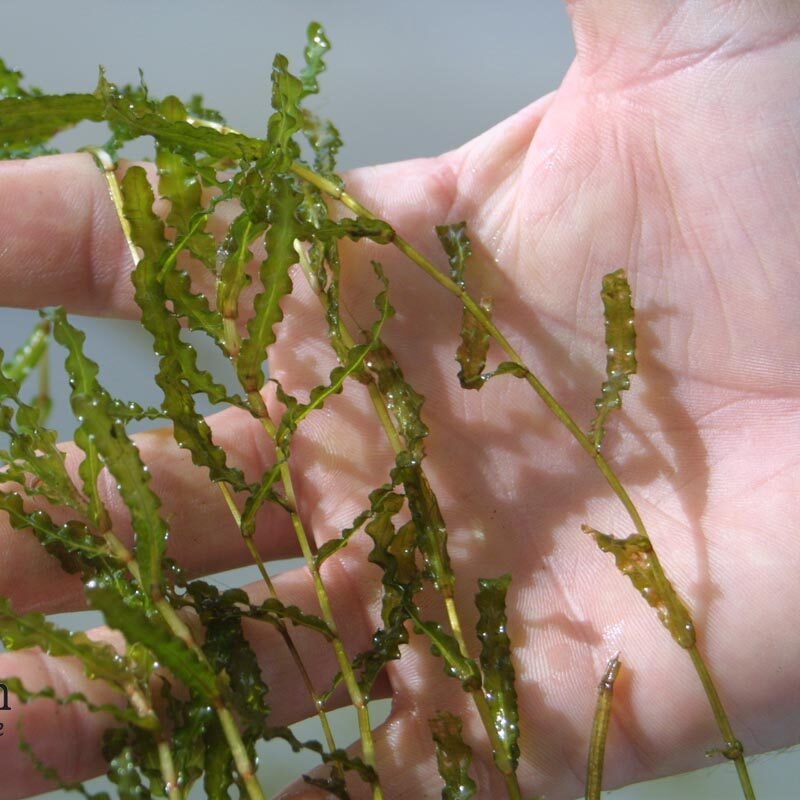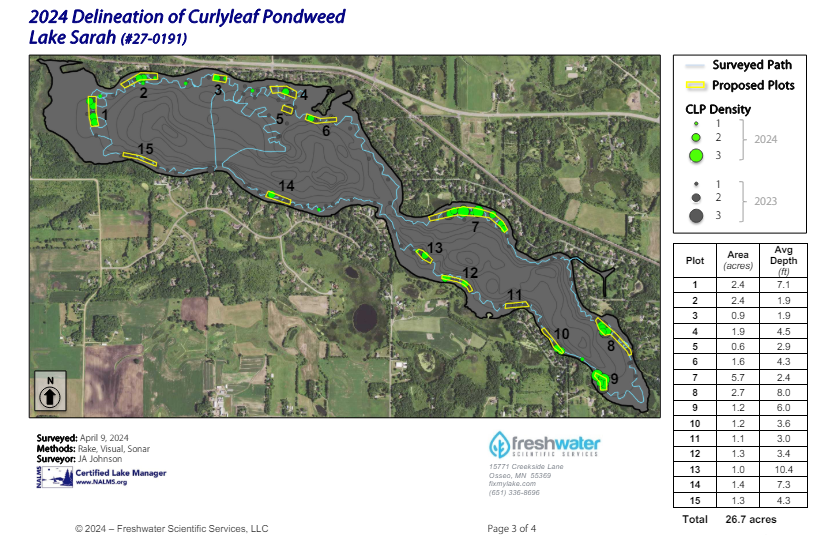Water Quality & Invasives Management
The Water Quality Committee works on projects related to cleaner water in Lake Sarah, and the ongoing monitoring of water quality and invasive species. This is important to the health and usability of the lake, as well as the desirability of Lake Sarah to residents and potential residents. Since 2011, the Lake Sarah Association has undertaken several key projects to improve water quality.
As our top priority, In an effort to remove Lake Sarah from the Impaired Waters List, LSIA is working with local and state agencies in mitigating phosphorus chemicals from runoff, and mitigation of phosphorus in the bottom substrates of the lake. Within this priority are several projects including Curly Leaf Pondweed control & watershed improvements, and an eventual Alum Treatment to lock phosphorous in the bottom of the lake.
In addition, we monitor the lake for invasive species, and take actions to eliminate these harmful species. Lake Sarah is under constant assault from farm and home chemicals run off from the surrounding watershed, invasive weeds, and animals. These factors all contribute to the water quality on Lake Sarah, and LSIA is taking on these issues individually and through our government partners (MEPA, DNR, Three Rivers Parks, and the Pioneer Creek Watershed Commission).
The Lake Sarah Watershed Map
Weed control treatment
Secchi disc reading for water clarity
CD3 Outpost at landing for cleaning boats and trailers at LS Landing. Courtesy of the Pioneer Creek Watershed Commission
Curly Leaf Pondweed
Current Projects
Since 2008, LSIA has been treating Lake Sarah for CLP and Milfoil. When the program started, it was much different than today, but very effective. The Association used to do whole lake treatments for the CLP and Milfoil. Today they are handled as separate surveys and treatments each year, and applied by commercial applicators.
Progress has been made over the years. Images show the extent of the treatment areas in 2013 and 2024. We used to treat 200-300 acres. Today, we treat less than 30 acres each year.
If we do not keep up these treatments as an association, we will go back to the days of choked water, algae blooms, and muck. These surveys and treatments are largely what your Clean Water Donation goes toward.
Curly Leaf Pond Weed (CLP)
2013 CLP Treatment Area >300 acres
2024 CLP Treatment Area <30 acres today
The LSIA Board reviewed the efficacy of the 2023 invasive weed management effort with the DNR and decided to adopt a different move forward approach for the management of Eurasian Milfoil on the lake.
In past years, LSIA used a chemical called Diquat to treat both Curlyleaf and Milfoil. Diquat kills weeds topically providing rapid visible surface level results. It is a cost effective but short-term solution requiring yearly or more frequent application. We will continue to use it for treatment of Curlyleaf on the lake.
Beginning last September (2023), we began treating Milfoil using a chemical called ProcellaCore. It is a more expensive treatment compared to Diquat because it is a species-specific chemical that kills Milfoil at the root providing multi-year control. Other lakes have experienced 3-5 years of control with a single treatment. We treated the East basin this Fall and will be treating the West basin in 2024.
Eurasian Milfoil
Lake Sarah has been fortunate to date that we have not been infested with Zebra Mussels like so many Minnesota lakes. With this invasive threat, LSIA has placed Zebra Mussel traps at the landing, and in other locations in the east and west basins in 2024. This will help monitor for infestation and hopefully catch it early enough to mitigate the infestation.
As a reminder, please remember to always clean your boat, live wells and bilge, and trailers thoroughly before launching them on Lake Sarah.
Also check your docks, lifts, and other items you pull out of the lake each year, and report any Zebra mussels you may find.
Zebra Mussel Monitoring
Zebra Mussel Traps
Watershed Improvement Projects
Lake Sarah, like many metro lakes, is on Minnesota’s impaired waters list. LSIA, along with our government partners, is developing and executing projects toward the goal of removing Lake Sarah from the Impaired waters list as a priority. This classification triggers, by law, that a Total Daily Maximum Load (TDML) study is conducted to identify all sources of chemical pollutants found in any given body of water. In 2011, after this study is completed, an action plan was created in cooperation with state, county, the watershed, and local municipalities. This plan outlines project by the Pioneer Creek watershed, along the north shore of Lake Sarah, that are in process of being planned, funded, and executed. It seeks to reduce Phosphorous and Nitrogen loading into Lake Sarah. While not complete, these projects should help reduce the chemical burden on the lake and have us delisted from the Minnesota Impaired Waters List.
The best way to familiarize yourself with this project is to read the “2024 Watershed Project Update” published by LSIAA in the fall of 2024.
From the Minnesota Pollution Control Agency: A TMDL is the maximum amount of a pollutant a body of water can receive without violating water quality standards, and an allocation of that amount to the pollutant’s sources. The TMDL process identifies all sources of a pollutant and determines how much each source must reduce its contribution in order to meet the standard. Once a body of water is added to the Minnesota Impaired Waters List, a TMDL must be developed for it. After impaired waters are listed, the MPCA organizes them into TMDL projects using the watershed approach. (ref. Minnesota Pollution Control Agency)
Excessive nutrients, particularly phosphorus and nitrogen, pose a significant problem for Minnesota’s lakes and rivers, as well as downstream waters including the Great Lakes, Lake Winnipeg, and the Gulf of Mexico. Nutrients are important for human and aquatic life. However, when levels exceed normal conditions, they can cause excessive algae growth, low levels of oxygen, toxicity to aquatic life, and unhealthy drinking water










